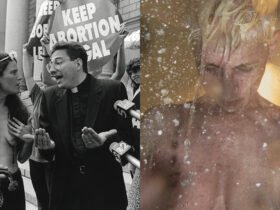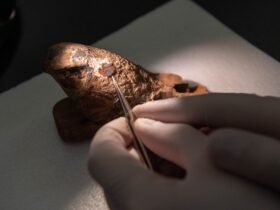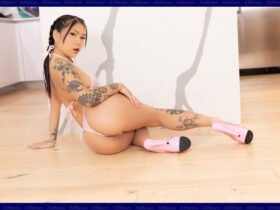
Flipping through a volume with a bit of sand in its spine, basking in sun, and in no rush — this is how we were meant to read art books. With summer around the corner and visions of balmy parks swimming in our heads, we decided to compile a non-exhaustive list of summer art reads. Reviews Editor Natalie Haddad takes a look at a new biography of Yoko Ono, while Editor-in-Chief Hrag Vartanian uncovers nuggets of wisdom in a reissue of Jack Whitten’s studio notebook. We also have a beach-read novel about a curator’s trip to Greece gone awry, a biography of Marsha P. Johnson with a focus on her artistic work, essays on Latinx art, and more on our shelf. Wear sunscreen and get reading! —Lakshmi Rivera Amin, Associate Editor
Jack Whitten: Notes from the Woodshed, edited by Katy Siegel

This is a delightful book that brings together 55 years of late artist Jack Whitten’s studio journal, featuring jotted-down notes, observations, idioms, sketches, and other oddities that chart the curious mind of the artist on every page. This is a reissue of a book that original came out in 2018, but given the current large retrospective of his paintings at the Museum of Modern Art and the renewed interest in his work created by his blue chip gallery, Hauser & Wirth, it’s a timely opportunity for his gallery to remind us of his words, if only to help move his art into museums and private collections.
At one point he writes, “Inclusiveness is a necessary ingredient of art. To exclude is a form of hate. Freedom is only possible when there is no need for the OTHER.” Elsewhere, he offers, “17 DEC: I MUST RECONSTRUCT NATURE IN MY IMAGE.” The book preserves the artist’s all-caps and crossed-out comments, which are certainly fun to read.
I don’t think this is a volume to be read from cover to cover, and I found it most useful when I opened a random page to meditate and reflect on Whitten’s pearls of wisdom. He mentions advice from elder artists, like Willem de Kooning and Franz Kline, the latter of whom he calls “always helpful,” and shares one key bit of advice that the stark gestural abstractionist gave Whitten and other artists: “The minute you step into that studio and pick up that brush, you are a part of art history and you’ll never be lonely.”I imagine those creatives who choose to keep Whitten’s studio journal alongside them in their own studios may find that the solitude of creating will not be lonely anymore, as they’ll feel in dialogue with someone who is egging them on. —Hrag Vartanian
Buy on Bookshop | Hauser & Wirth Publishers, March 2025
Amy Sherald: American Sublime, edited by Sarah Roberts

Few are the artists who can boast their own brand of realism. With her unique portraits of contemporary Black Americans, Amy Sherald is a stellar example of one who can. Released in conjunction with her mid-career survey at the Whitney Museum of American Art, this catalogue contextualizes the artist’s oeuvre within American painting traditions, Black literature, this country’s troubled race relations, and her own family history. It’s the second-best thing after visiting the show in person, where encountering Sherald’s portrait of Breonna Taylor, the 26-year-old Black American woman killed by police in Louisville, Kentucky, in 2020, moved me to absolute tears. —Hakim Bishara
Buy on Bookshop | Yale University Press and the San Francisco Museum of Modern Art, November 2024
A Handbook of Latinx Art, edited by Rocío Aranda-Alvarado and Deborah Cullen-Morales

In recent years, a wave of research has attempted to address the erasure of Latinx artists — or Latine, both terms denoting individuals of Latin American and Caribbean descent who live in the United States — who scholars argue are marginalized on two fronts: Not considered “American” enough to be included in broader surveys of this nation’s art, they are often seen as too much so to fit snugly within the “Latin American” canon, as Arlene Dávila argued in her pivotal book Latinx Art (2020). This new compendium of essays traces the roots of Latine art and its evolutions between the 1970s and the present day, from El Museo del Barrio founder Raphael Ortiz’s “Culture and the People” (1971) to Luis Camnitzer’s epic “Wonder Bread and Spanglish Art” (1990) and Teresita Fernández’s more recent “Liminal Places” (2023). Perhaps the most notable shared attribute among these texts is all that they do not share, illuminating the convergence of class, ethnicity, race, immigration status, and other intersectional factors that complicate the notion of a tidy, retrospective-ready Latine art history. A note: Although the book covers a wide geographic region of the US, its ethnographic focus is on Mexican-American, Puerto Rican, Cuban-American, and Dominican-American communities, who make up the majority of the country’s Latine population. In the coming years, I hope to see our field expand its scholarship to examine the experience of Venezuelan Americans, one of the fastest-growing Latine origin groups. —Valentina Di Liscia
Buy on Bookshop | University of California Press, February 2025
Yoko: A Biography by David Sheff

In the prologue to Yoko: A Biography, author David Sheff writes of the eponymous artist’s legendary 1964 performance piece, “‘Cut Piece’ meant different things to different people.” A deceptively simple statement, the same can be said of Yoko Ono herself. Few people in the world have more acutely experienced the double-edged sword of fame. Only in recent years has the significance of her art and activism finally received some of its due, after decades being overshadowed by her celebrity (and notoriety, to some) as John Lennon’s wife and collaborator. In Yoko, Sheff, a journalist who became a longtime friend, provides a detailed account of the artist’s life that is sympathetic without avoiding the rough patches. And, importantly, he reminds readers who know her as a renowned artist and musician of the sexist and racist maligning, and worse, that she endured for years from the press and the general public. Though the book is about far more than just her art practice, it makes clear that art has been at the center of the nonagenarian’s life and self-identity, and it considers something that separates her art from that of many of her feminist and Fluxus peers: despite the gravity of performances like “Cut Piece,” as well as the traumas she was working through, a sense of positivity permeates her oeuvre — not that of naïveté, but of survival. —Natalie Haddad
Buy on Bookshop | Simon and Schuster, March 2025
Vanessa Bell: Modern Living by Rosalind McKever

It was a quintessentially British day — that is, damp and overcast — when I visited Charleston one summer in middle school. Once a meeting place for the Bloomsbury crowd, the farmhouse was the longtime home of artists Vanessa Bell and Duncan Grant, whose creative spirits live on in each delightfully embellished room: wobbly hand-painted chevrons in the dining room, watery tilework around the windows, gray paisleys dotted with the suggestion of white flowers. I was so moved by Bell’s ingenuity that I attempted to paint the paisley pattern onto my own bedroom walls; something told me Bell would approve of the imperfections. Modern Living, a slim, square tile of a volume perfect for summer reading, walks us through the Charleston rooms and into the rest of Bell’s incredible artistic output, from floral paintings and portraiture to designs she produced at the Omega Workshops and lithograph illustrations, book covers she designed for novels by her younger sister, Virginia Woolf. Delving into this condensed guide to her radical work and life is essential for anyone who, as author Rosalind McKever writes, shares Bell’s belief in “the central tenet of modernism: to blend art and life.” —LA
Buy on Bookshop | Thames & Hudson, May 2025
Hervé Guibert: The Only Face, edited by Jordan Weitzman and translated by Christine Pichini

Amid a crowd in a Czech monastery in the late 1970s to late ’80s, Hervé Guibert is suddenly struck: For one perfect instant, that tangled mass of humanity reconfigures itself into a path leading his gaze to a face, “framed like a jewel,” looking back at him — it’s a coup de foudre, literally, a bolt of lightning. He fumbles for his camera, turns the focus to infinity, and captures the moment.
Guibert was a French writer and photographer perhaps most famous for writing To the Friend Who Did Not Save My Life (1990), which played a large part in shifting French perceptions of HIV/AIDS, the disease that killed him one year after the book’s publication, or for being a friend and lover to the writer and philosopher Michel Foucault. Originally conceived as an exhibition catalog to accompany a gallery show of his photos in Paris, The Only Face (2025) offers a tantalizing glimpse of the warm, aesthetically sharp, and humanistic mind we lost. It’s a slim volume consisting of just the above essay describing his visit to the monastery; a suite of photographs of friends, lovers, and strangers — Sienna sunlight catching whisps of smoke rising from a prostrate figure at a desk by the window like a soul, a “self-portrait” of a painting that centers not the likeness but the cracks in its surface — and a short essay by photographer Jordan Weitzman, who put this book together.
Thank god Weitzman read the French original from 1984 on a whim, and was possessed to publish its translation into English. Otherwise, we Anglophones would have missed this thoughtful, incandescent treatise on photography, as Weitzman puts it, with its interjecting, its prevaricating, and double-backing. It feels like an intimate conversation with a talented and anxious confidant, or maybe a fretful superego: “I think that in my case, photography-wise, what’s interesting is my resistance to photography, the fractious, careful, suspicious way that I practice it.” We would’ve missed Guibert’s great proclamation of the purpose underlying his work of all mediums: “to bear witness to my love.” —Lisa Yin Zhang
Pre-order on Bookshop | Magic Hour Press, May 2025
The Nude by C. Michelle Lindley

With Y2K around the corner, ambitious American curator Elizabeth Clarke touches down on a small Greek island to acquire a rare sculpture of a female nude. Freshly divorced and afflicted by a litany of maladies, including mysterious migraines, a benzodiazepine dependency, and a traumatic backstory that defies limitation, this trip is Clarke’s final, desperate attempt at self-actualization by way of “winning” her career. As she grows closer to her translator and his beautiful, enigmatic wife — a talented young photographer grappling with darkness of her own — it becomes clear that nothing is as it seems, starting with the statue, whose origins are far murkier than her discoverers promised. C. Michelle Lindley’s The Nude is not a subtle novel, but it’s easy enough to let go of the baroque writing style and at times incongruous choice of words and slip into the island scenery, where you can enjoy tantalizing descriptions of food (I’m still contemplating a delightful passage about a honeyed-feta-phyllo pastry) and learn something about Ancient Greek art history from someone who obviously adores it. Finishable in one, maybe two, trips to the beach. It’s a breeze. —Alexandra Bowditch
Buy on Bookshop | Atria Books, July 2024
MARSHA: The Joy and Defiance of Marsha P. Johnson by Tourmaline

This forthcoming biography approaches the legacy of Marsha “Pay It No Mind” Johnson with a deserved depth of care and admiration, offering an account of her remarkable life. Artist, filmmaker, and activist Tourmaline’s writing makes Marsha’s magnetic humor, wit, and warmth palpable. Tourmaline’s ouvre is rooted in a deep scholarship of and connection to Marsha’s influence; she and artist Sasha Wortzel directed, wrote, and produced a fictional short called “Happy Birthday, Marsha!” (2018), and Tourmaline’s contribution to the 2024 Whitney Biennial, “Pollinator,” also weaves in references celebrating Marsha’s life.
The book situates Marsha, celebrated for her triumphs as an activist, as a textile artist who stitched beautiful political banners and a performance artist who acted alongside downtown troupes like the Hot Peaches and the Angels of Light. It reveres her devoted role as a mother to many of the community members she helped, housed, and cared for while navigating her own struggles with mental health and housing insecurity, and as a victim of violence.
MARSHA’s chapters flow chronologically, beginning with her childhood in New Jersey, and include anecdotes from her many friends, family members, and collaborators, woven with relevant academic references. Though Marsha is perhaps best known today for her key role in the 1969 Stonewall Riots and subsequent Gay Liberation movement, this book also explores lesser-known narratives of the eponymous muse’s life, like cofounding STAR, a radical collective of trans activists; her support during the HIV/AIDS epidemic; and her advocacy for sex workers, to name only some of her monumental impact on the LGBTQ+ community of New York City and beyond. —Jasmine Weber
Buy on Bookshop | Tiny Reparations Books, May 2025
Bad Outdoorsmen by Katie Hargrave and Meredith Laura Lynn
How would you perform alone in the wilderness? When it comes to survivalism, artists Katie Hargrave and Meredith Laura Lynn aren’t faking it, even if they don’t fit the mold of a typical “outdoorsman.”

In short, Bad Outdoorsmen is an exhibition catalog that tracks a series of artworks Hargrave and Lynn made in Florida as part of a Crisp-Ellert Art Museum Artist Residency in the fall of 2022. The longer story is that the book’s mere 76 pages present the artists’ funny yet poignant critique of a certain brand of wilderness-based settler colonialism — the kind embodied and enacted by the likes of John Muir, John James Audubon, and other White men who weren’t particularly good at being outside, what with the bugs, weather, and all. Their work also looks at contemporary American society’s obsession with wilderness consumerism, rife with what Hargrave recognizes as “colonial fantasies.”
Those fantasies extend to mainstream entertainment media such as the TV series Alone (2015), in which wanna-be-survivalist participants battle nature in an effort to survive 100 days alone in a remote location, relying on their wits and a few personal possessions to stay alive and win up to a million dollars.
Hargrave and Lynn have created their own Alone audition video, “performing” in the landscape and proposing that “good TV can also push back against an idealized (not to mention sexist and racist) vision of the outdoors.” But the artists don’t isolate themselves from the critical issues; the nature of their implication is visible in hand-sewn ghillie suits of camouflage fabric printed with Alone episode video stills — images that comprise most of the book. The inclusion of selected comments from their Instagram feeds further draws attention to how polarizing issues of visibility can be. And with leaves from the suits incorporated into the book’s overall tactical design, the result is a clever and conceptually satisfying summer read. —Nancy Zastudil
Image: Bad Outdoorsmen (design direction by Luminosity Lab, photo by The Book Photographer)
Buy the Book | Workshop Arts, March 2025
Mona’s Eyes by Thomas Schlesser, translated by Hildegarde Serle

Henry Vuillemin’s beloved granddaughter, Mona, appears to be losing her sight. He may have only a year to show her as much beauty as he can before her world goes dark. He hatches a plan to study a single artwork per week with the 10-year-old. Then she can carry the memory of these seminal pieces spanning 300 years, from Botticelli and Leonardo da Vinci to Boltanski and Soulages, into the unseen future. They work their way through highlights of the Louvre, Musée d’Orsay, and Centre Georges-Pompidou. There, Mona proves herself not only an apt student, but a preternaturally deft critic, delighting her doting grandfather — no slouch himself in the art history biz. No surprise that the novel’s author is a professor of art history at the École Polytechnique in Paris; his characters channel his dazzling command of the greats. While a fictionalized Art History 101 — dropped into a plot frequently both sentimental and implausible — may sound dreadful, it is the book’s guileless veneration of the visual world that elevates it beyond its cornier elements. Viewing Whistler’s “Mother,” Vuillemin asserts that “to paint was, first and foremost, to love.” So, too, to appreciate art this movingly. —Melissa Holbrook Pierson
Pre-order on Bookshop | Europa Editions, August 2025
New Catalogs & Monographs













Leave a Reply